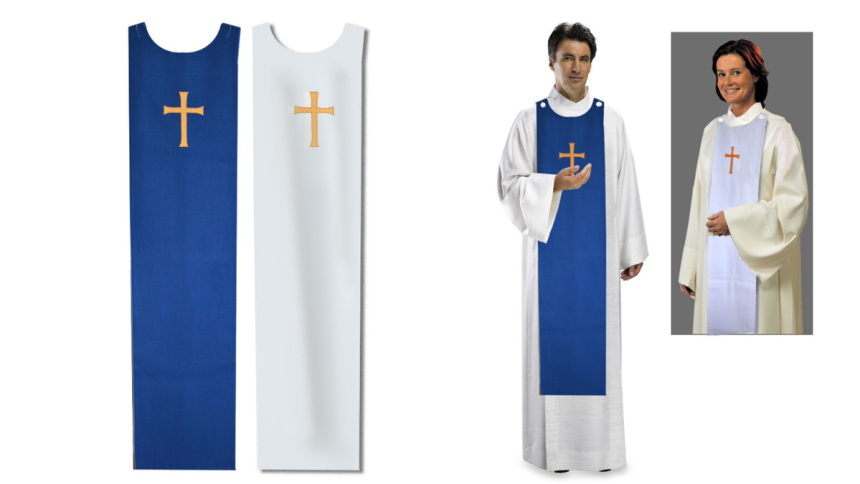In many worship settings, visual elements are vital in deepening the spiritual experience. Among these, choir stoles stand out as both functional and symbolic. Worn around the neck by choir members, these elegant strips of fabric enhance the choir’s appearance while reflecting centuries of Christian tradition and liturgical meaning.
What Are Choir Stoles?
A choir stole is a long, narrow piece of cloth worn over the shoulders, typically on top of a choir robe. While not a liturgical vestment in the same sense as a clergy stole, it still holds significant meaning in many worship traditions. Choir stoles provide uniformity in the choir’s appearance and may reflect the season, special occasions, or even the identity of a specific church or congregation.

Choir stoles can be simple or ornate and made from various materials such as satin, silk, or polyester blends. They often feature symbols like crosses, doves, flames, or musical notes, and may be color-coded to align with the liturgical calendar.
A Brief History of the Choir Stole
The stole’s origins go back to ancient Rome, where ceremonial garments evolved into ecclesiastical vestments. Over time, the clergy stole became a sign of ordination and ministerial authority, while the choir stole emerged as a non-ordained counterpart, symbolic but not sacramental.
In many denominations today, choir stoles help bring color and context to the service. They may change throughout the church year to reflect different seasons:
- Purple during Advent and Lent, symbolizing repentance and preparation.
- White or gold during Easter and Christmas, expressing joy and purity.
- Red for Pentecost, representing the Holy Spirit and the fire of inspiration.
- Green in Ordinary Time signifies growth and renewal.
This use of color helps congregants visually connect with the spiritual flow of the calendar year.
Function and Symbolism in Modern Worship
Beyond their visual appeal, choir stoles serve to unify the choir. When choir members wear matching stoles, it creates a cohesive look that supports their role as a collective voice in worship. This unity enhances the congregation’s focus on the message rather than the individual singers.
Choir stoles can also be customized to commemorate events or reflect the identity of a particular choir. For example, youth choirs may wear bright, modern stoles embroidered with symbols of faith, while anniversary celebrations might include a custom-designed stole for long-standing members.
If you’re looking for guidance on selecting or designing choir stoles, mygradstoles.com offers helpful insights and examples to support both traditional and contemporary worship styles.
Selecting the Right Choir Stoles
When choosing stoles for a choir, consider the following:
- Material: Heavier fabrics like brocade create a rich, formal look, while lighter materials offer comfort and flexibility.
- Color and Seasonality: Choose colors that align with the church calendar or a special liturgical season.
- Symbolism: Embroidered designs can add depth and meaning—musical notes for song, doves for peace, flames for the Spirit.
- Fit and Length: Ensure that the stole complements the robe and allows for comfortable movement during performances.
Custom designs can make choir stoles more meaningful and visually striking. Churches often opt for personalized embroidery, such as the church’s name, a scripture verse, or an anniversary date.
A Touch of Culture and Creativity
In today’s diverse worship communities, choir stoles are also becoming a way to express cultural identity. Churches with multicultural memberships may incorporate fabrics, patterns, or symbols from various traditions—African kente cloth, Celtic knots, or Native American beadwork, for example. This creative use of design helps connect the church’s mission to its community.
Even in more traditional settings, custom stoles can add a personal and memorable touch. Whether you’re planning a special event, honoring a long-time choir director, or simply refreshing your choir’s look, a well-designed stole can speak volumes without saying a word.
Conclusion
Though often overlooked, choir stoles are an essential part of the visual and symbolic language of church music. They bring unity to the choir, reinforce the rhythm of the liturgical year, and serve as reminders of the sacred role music plays in worship. Simple in form but rich in meaning, the choir stole continues to be a timeless garment, blending tradition, identity, and expression into one graceful design.
Whether you’re a church leader, choir director, or member of a music ministry, taking time to consider the use and design of choir stoles can enrich your worship experience—and that of your entire congregation.
Lynn Martelli is an editor at Readability. She received her MFA in Creative Writing from Antioch University and has worked as an editor for over 10 years. Lynn has edited a wide variety of books, including fiction, non-fiction, memoirs, and more. In her free time, Lynn enjoys reading, writing, and spending time with her family and friends.















